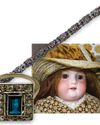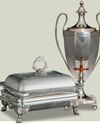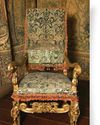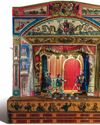
Having supplied a demanding nobility with neoclassical wares of unrivalled quality throughout the late 18th century, Worcester factories went into decline and in the 1830s the glory shifted to Staffordshire, where hundreds of porcelain factories had emerged. From about 1800 onwards, the Staffordshire Potteries began generating a huge output, not only for the nobility, but also for the rapidly emerging middle class and a growing global export market.
The Industrial Revolution was underway, and entrepreneurs were making large sums of money that would not have been accessible before industrialisation. Now, anyone hard-working with intelligence and a bright idea could lay their hands on investment, make a fortune and move up society's ladder. And this wasn't just in Britain: as the Empire catapulted these ambitious young people into all corners of the world, and the United States turned to industrialisation, suddenly many more people could afford porcelain. And thus a new style of decorative arts was born: Rococo Revival.
By the 1820s the prevailing neoclassical style had ended up in a bit of a muddle. The Prince Regent (later King George IV) was largely responsible for first popularising and then wrecking it: he was at the centre of a race among the nobility to spend more, be more lavish, embrace more gilt and decorations, which of course undermined the very idea of simplicity that the neoclassical style was based upon.
This story is from the April 2023 edition of Homes & Antiques.
Start your 7-day Magzter GOLD free trial to access thousands of curated premium stories, and 9,000+ magazines and newspapers.
Already a subscriber ? Sign In
This story is from the April 2023 edition of Homes & Antiques.
Start your 7-day Magzter GOLD free trial to access thousands of curated premium stories, and 9,000+ magazines and newspapers.
Already a subscriber? Sign In

Lisa Coppin
The Cotswold Company’s chief creative officer shares the pieces that mean so much to her

TRAVEL
Six of the best pineta, plus a festive trip to Covent Garden. Review of The Orange, Belgravia by Katie Pike, travel stories

OLD SHEFFIELD PLATE
Stumbled upon by chance, this ingenious material was a more affordable option than solid silver, and well-preserved examples are particularly desirable today

Merrily on high
Summoning servants since the 1700s, bell boards create instant English country-house style (even if you don't have any servants). Emma Longstaff dons her pinny

Let it snow
Nostalgic, magical and highly collectable, snow globes are curious objects of wonder that never fail to instil joy

Velvet Crush
Once the preserve of the wealthy, velvet finally touched all levels of society, thanks to advances in its production process

Celebrating in the Stable
Antiques dealer Julia von Hülsen specialises in Gustavian pieces - all of which look perfectly placed in her German home

THE SHOW MUST GO ON
Victorian toy theatres charming and exquisitely designed miniature worlds have inspired theatre royalty for decades. Today, the tradition is being kept alive by a small but talented network of makers

NICHOLAS LEES
The ceramic artist talks to Dominique Corlett about new ways of working with clay and blurring the edges of solid objects

Candy CHRISTMAS
Pastel hues, vintage decorations and bowls of sweet treats: the festive run-up is gloriously joyful at Bettina Færgeman's historic Copenhagen apartment, where there's an emphasis on entertaining...